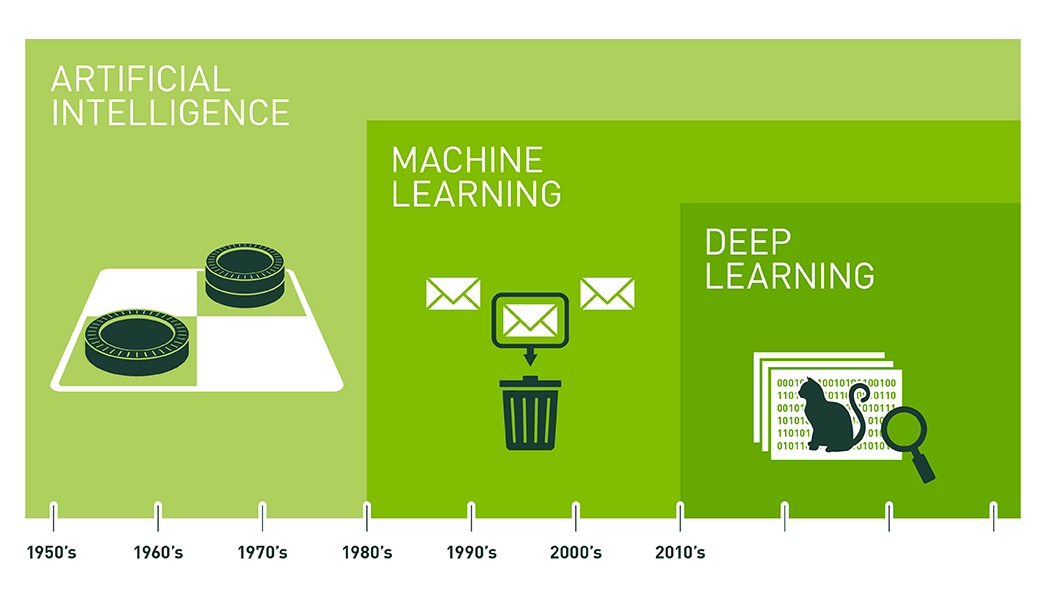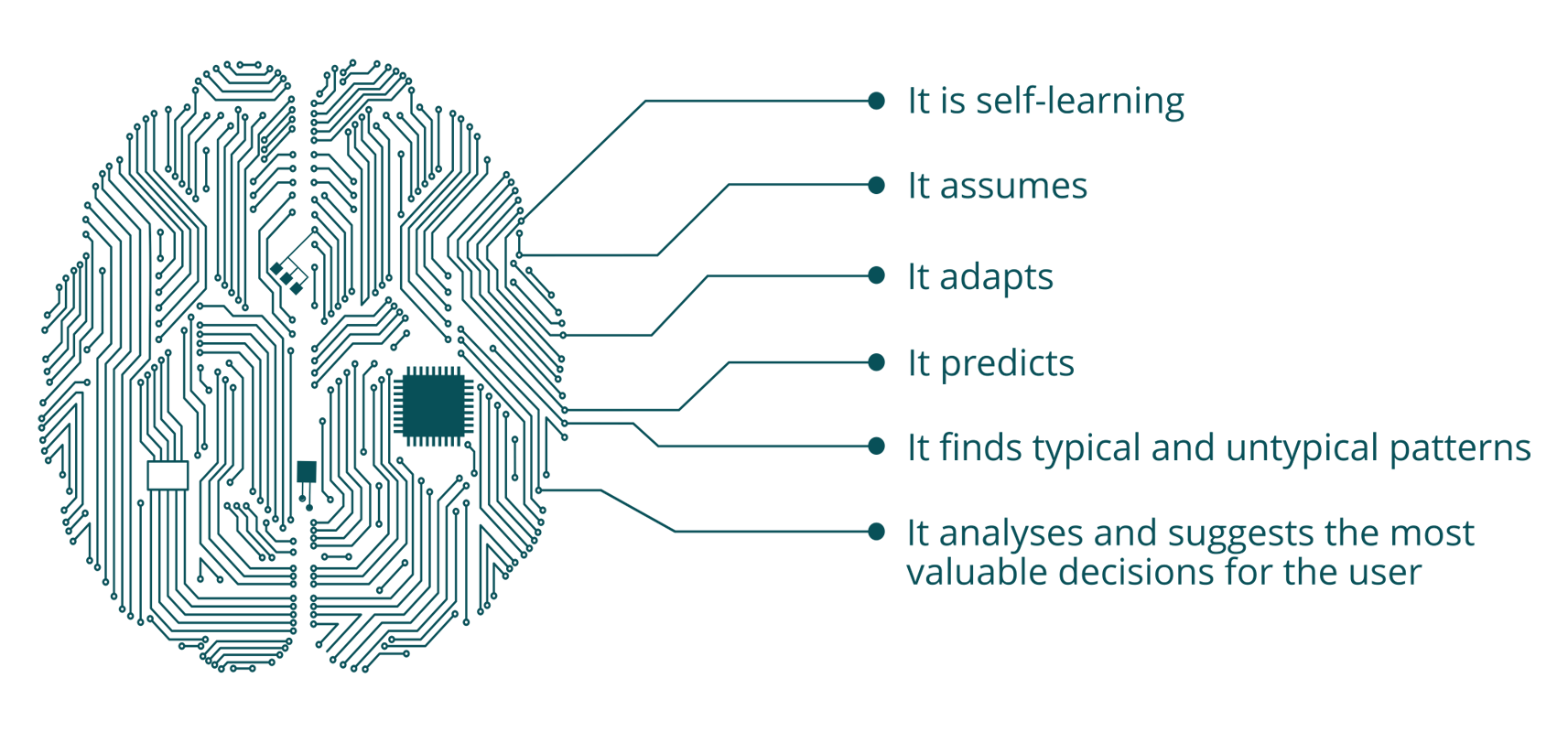In the modern days of computation, computers have become smarter by the days. And part of that, is because of AI, machine learning and deep learning.
When we first hear about the term "AI", some may refer it to something in science-fiction movies. Some others may heard it from the so-called "AI" in video games. Going forward, AI surfaced the term "Machine Learning" and "Deep Learning".
Sometimes people have used deep learning and machine learning interchangeably with artificial intelligence. With each of them overlapping, their meaning are easily confused. As a result, the differences between the three can be very unclear.
These terms are familiar with one another. However, they are in fact all different, despite heavily connected.

Short definition:
- AI is how we make a computer to mimic human behavior in some way.
- Machine learning is a subset of AI that consists of the techniques to make computers figure things out by themselves.
- Deep learning is a subset of machine learning, which enables computers to solve more complex problems.
And here is the more detailed explanation:
AI, The Machine Intelligence
Artificial intelligence is sometimes called machine intelligence, and its how intelligence is demonstrated by machines.
Founded as an academic discipline in 1956 by John McCarthy, the term "artificial intelligence" is applied when machines can mimic the "cognitive" functions that humans associate with other human minds, such as planning, understanding language, recognizing objects and sounds, learning, and problem solving.
Artificial Intelligence is considered the general category, common to all three. As an explanation, AI would be the bigger one, which encapsulates both machine learning and deep learning.
AI falls into three different categories which are based on their capabilities. They are:
- Artificial Narrow Intelligence (ANI): Often referred to a Weak AI.
- Artificial General Intelligence (AGI): Also regarded as a Strong AI.
- Artificial Superintelligence (ASI): This type of AI possesses intelligence far surpassing that of the brightest and most gifted human minds.
But in general, the can be attributed to either "general AI" which considers AI to have all of the characteristics of human intelligence, or "narrow AI" which exhibits some facet(s) of human intelligence, and can do that facet extremely well, but is lacking in other areas. "Superintelligence" is still considered plausible in an era where machines surpass humans in abilities, as AI supremacy draws near.
As the development of AI continues and is adopted in many fields and industries, its scope became disputed: as machines become increasingly capable, tasks considered as requiring "intelligence" are often removed from the definition.
The result is AI becoming referred to the output of a computer, when it shows something intelligent - exhibiting intelligence that is artificial. Here, AI has a long way to go.
Read: Paving The Roads To Artificial Intelligence: It's Either Us, Or Them
Machine Learning: The Signs of Cognition
This term was first coined by Arthur Samuel in 1959. He defined it as "the ability to learn without being explicitly programmed."
In its core and basic form, machine learning is the practice of how computers use algorithms to parse data, learn from it, and then make a determination or prediction about something. Machine learning allows computers to learn from data by determining the patterns, learn from that pattern, to then expect or differentiate that pattern from other patterns in the future.
In short, machine learning relies on data given to the model.

Here, a computer is given data to the model that includes the answer to the problem for each input set. With each given input parameter, or feature, the model adjusts its function to match the data. Then, when given any other input data, the model can execute the same function and come up with an accurate output.
Other factions of machine learning are "Unsupervised Learning" and "Reinforcement Learning."
The term is used because early researchers realized that some problems can be difficult for computers to solve using hard-coded algorithms. They found that fixed, rule-based systems didn’t work very well on things like image recognition or extracting meaning from text, simply because there are too many variables to consider.
This was when people considered machine learning as computers that not only mimic human behavior (AI), but also mimicking how humans learn.
Using this method, machine learning showed a lot of promise because it could solve some complex problems that pure algorithms couldn't handle.
However, machine learning on its own is not capable of tackling simple questions elementary school students can solve with ease. Like for example: how many dogs are there in a picture, or are they wolves?
This is where machine learning falls short.
Deep Learning. How Computers Mimic Humans
Simply put, deep learning is all about AI using neural networks with a lot more neurons, layers and interconnectivity.
To pass the limits of machine learning, humans created neural networks in which artificial neurons (neurons, connected by synapses, are the major elements in biological brain) are simulated in software to solve certain problems. They are densely interconnected, and organized into layers of nodes that are "feed-forward."
What this means, data that flows through them goes only in one direction.
An individual node can be connected to several nodes in the layer beneath it, from which it receives data, and several nodes in the layer above it, to which it sends data. This is where the term "deep learning" came from.
In each incoming connections, a node will assign a number known as a “weight.”

When the network is active, the node receives a different data item over each of its connections. The algorithms then multiply them by their associated weight. It then adds the resulting products together, yielding a single number. And if that number is below a threshold value, the node stops passing data to the next layer. But if the number exceeds the threshold value, the node "fires" by sending the number ( the sum of the weighted inputs) to the next node in the connection.
When a neural net is being trained, all training data is fed to the bottom layer, called the input layer, and passes through the succeeding layers, getting multiplied and added together in complex ways. All until it radically transformed at the output layer.
It is during training that the weights and thresholds are continually adjusted, all until training data with the same labels consistently yield similar outputs.
So basically here, deep learning is machine learning on steroid. It is inspired by the structure and function of the brain, namely the interconnecting of many neurons. Artificial Neural Networks (ANNs) are algorithms that mimic the biological structure of the brain.
In theory, the more neurons, layers and interconnectivity, the better an algorithm can extract pieces of valuable information - adding more variables to the computation.
For example, when a simple neural network can extract images for steering a self-driving car. A more sophisticated neural network can have additional layers to process something different, like, the first could be detecting edges for the sides of the road. Another layer could be detecting the lane lines in the image, and another possibly other cars, humans, animals and so forth.
Deep learning here advances machine learning to a whole new level. So if humans want to advance computing from autonomous cars to Go-playing supercomputers to speech recognition, robots that are aware of the environments and more, it's deep learning that works behind the scene.
In the modern days of AI, it's deep learning that really makes computers smarter.
And regardless of their differences, AI, machine learning and deep learning continue to make profound impacts on our world.

Conclusion
The world has evolved, and so did computers.
Using algorithms, we can make computers smarter by making it capable of drawing conclusion. But in many cases of computation, especially when we put computers to the test using the real world we live in, there are too many variables to consider that pure algorithms just won't be sufficient.
AI refers to devices exhibiting human-like intelligence in some way.
But as the AI revolution in incredibly fast, it has become impossible to forecast accurately. And this created many subsets.
One subset of AI includes machine learning, which makes algorithms learn from the data it is fed on using a neural network that mimics the human brain.
And finally, deep learning is a subset of machine learning, which uses many-layered neural networks to solve more difficult problems, in the hopes of making computers even more capable of showing "intelligence".
Other subsets include and not limited to: decision tree learning, inductive logic programming, clustering, reinforcement learning, and Bayesian networks and others.